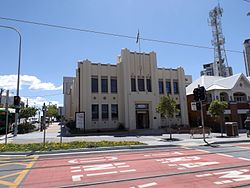Southport Town Hall, Queensland
| Southport Town Hall | |
|---|---|

Building in 2015
|
|
| Location | Nerang Street, Southport, Gold Coast City, Queensland, Australia |
| Coordinates | 27°58′04″S 153°24′47″E / 27.9677°S 153.413°ECoordinates: 27°58′04″S 153°24′47″E / 27.9677°S 153.413°E |
| Design period | 1919–1930s (interwar period) |
| Built | 1935 |
| Built for | Southport Town Council |
| Architect | Hall & Phillips |
| Official name: Southport Town Hall (former), Gold Coast City Hall, Gold Coast Town Hall, South Coast Town Hall | |
| Type | state heritage (landscape, built) |
| Designated | 5 October 1998 |
| Reference no. | 601649 |
| Significant period | 1930s-1940s (historical) 1935-ongoing (social) 1930s (fabric) |
| Significant components | counter, lawn/s, council chamber/meeting room, foyer – entrance, furniture/fittings, views to, office/s |
| Builders | H Cheetham |
Southport Town Hall is a heritage-listed former town hall at Nerang Street, Southport, Gold Coast City, Queensland, Australia. It was designed by Hall & Phillips and built in 1935 by H Cheetham. It is also known as Gold Coast City Hall, Gold Coast Town Hall, and South Coast Town Hall. It was added to the Queensland Heritage Register on 5 October 1998.
The Southport Town Hall was constructed in 1935 on the corner of Davenport and Nerang Streets, by the Southport Town Council replacing an earlier timber structure built in the nineteenth century. The building was designed by prominent Brisbane architects, Hall and Phillips, and is one of a number of buildings designed by the partnership which demonstrate a strong Art Deco influence.
The Nerang Division was formed in the nineteenth century to provide local government for the emerging community at the southern end of coastal Queensland. In 1883 Southport received separate local government representation when the Southport Divisional Board was formed. In the 1880s the popularity of Southport as a seaside holiday destination surged. Southport developed as an alternate resort when Sandgate became more accessible with the introduction of the Sandgate rail line in 1882. Logging in the Southport area had commenced in the late 1850s, and by 1875 the first sales of land opened the area for settlement. By the 1880s major Brisbane families favoured Southport as the principal sea-side area. The construction of major schools, banks and hotels stimulated Southport's growth the premier nineteenth century resort as did the presence of the Governor's residence in the 1890s. The South Coast railway line, an extension from Beenleigh to Southport was opened in 1889 making Southport more accessible from Brisbane.
...
Wikipedia


